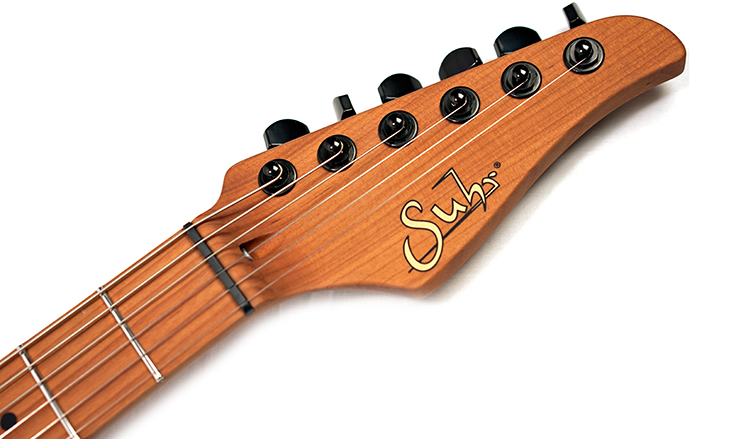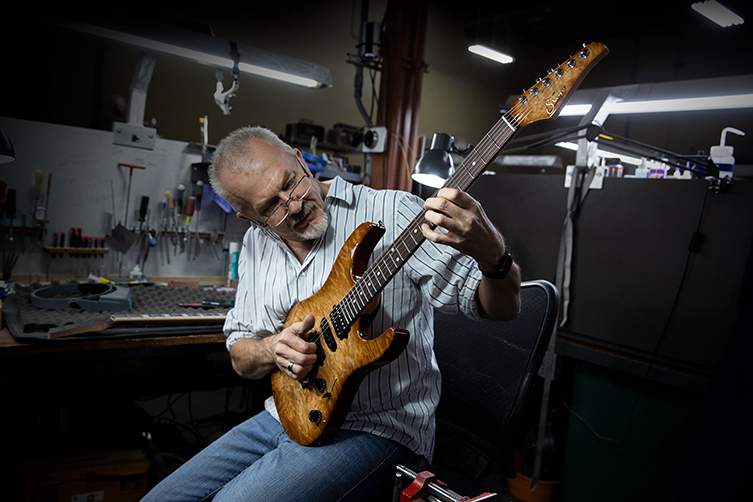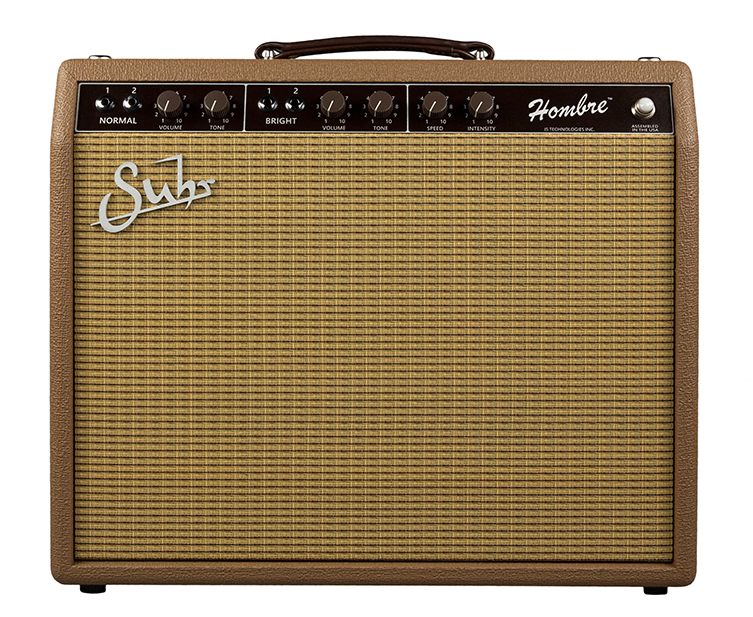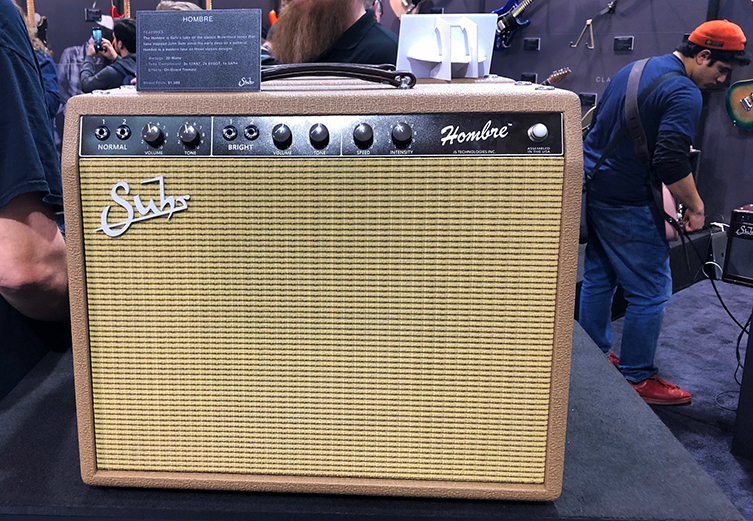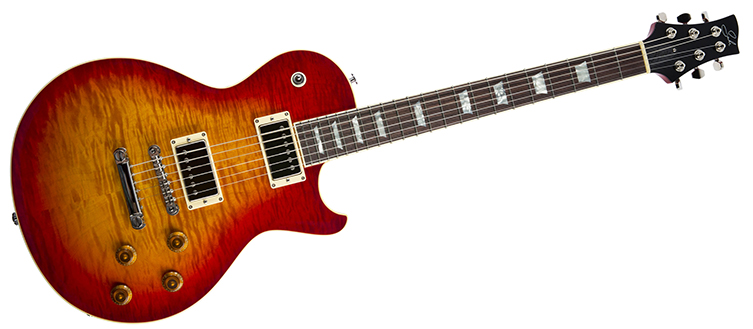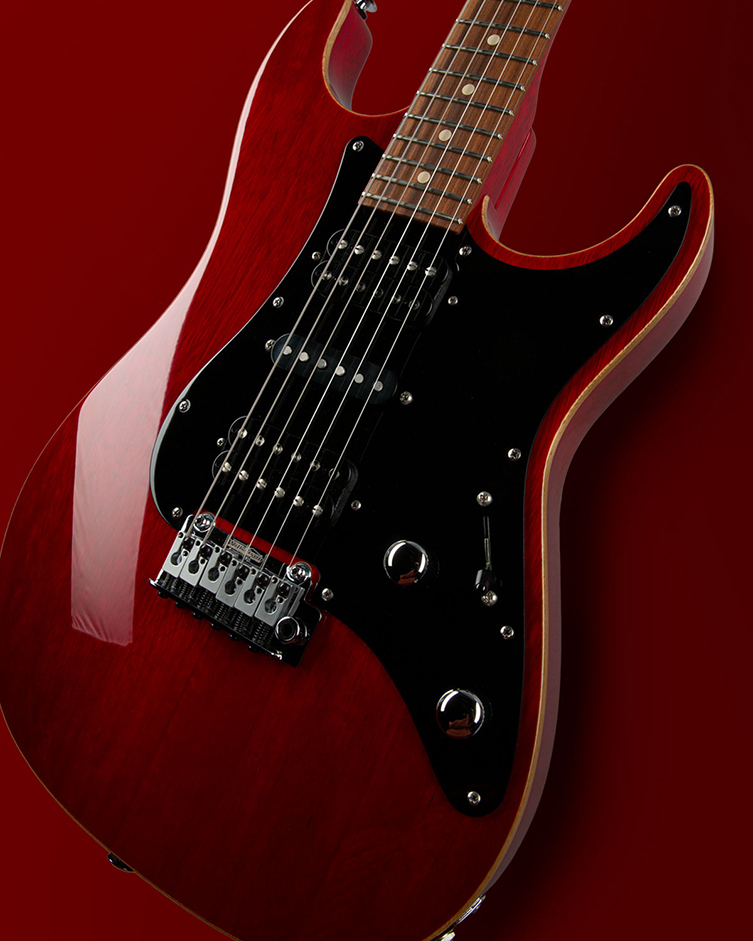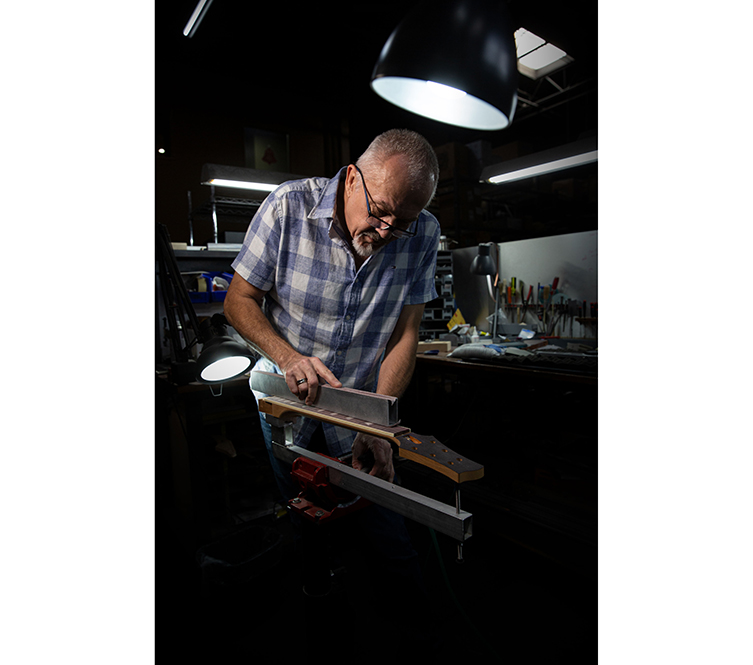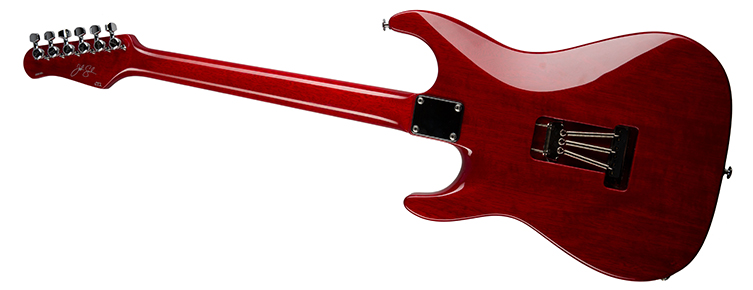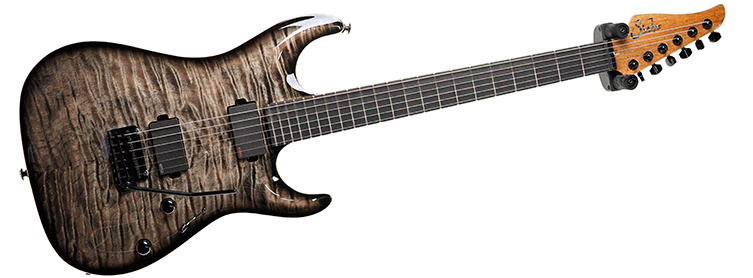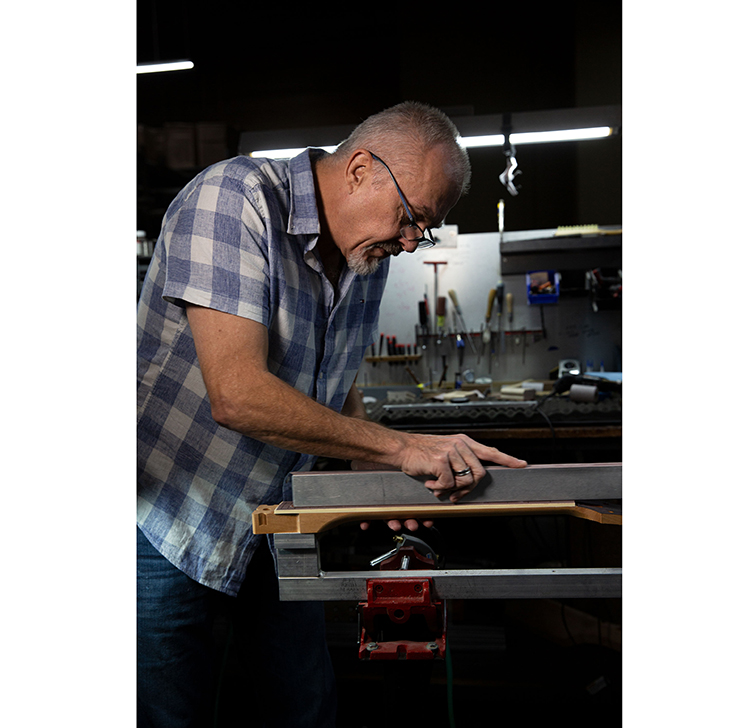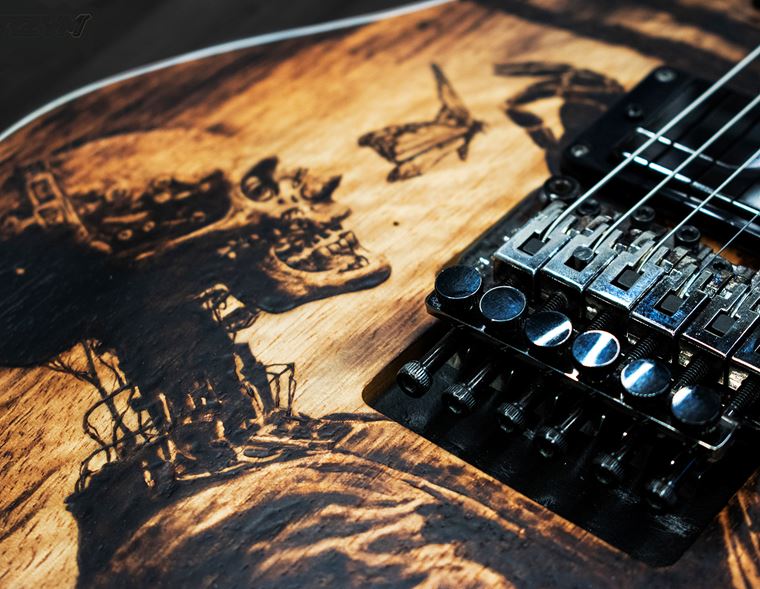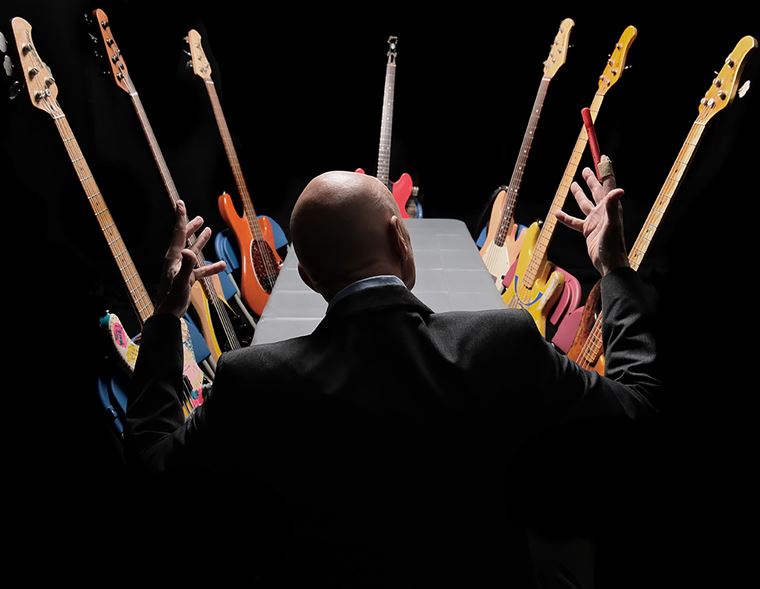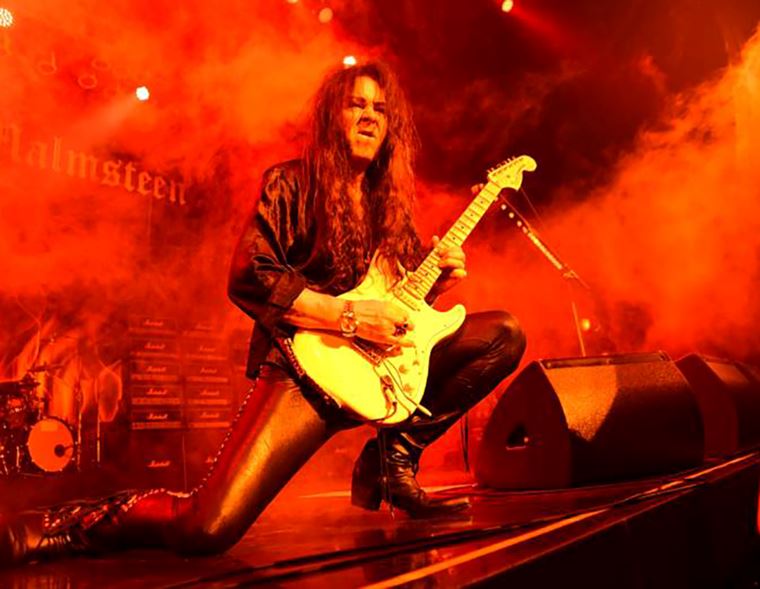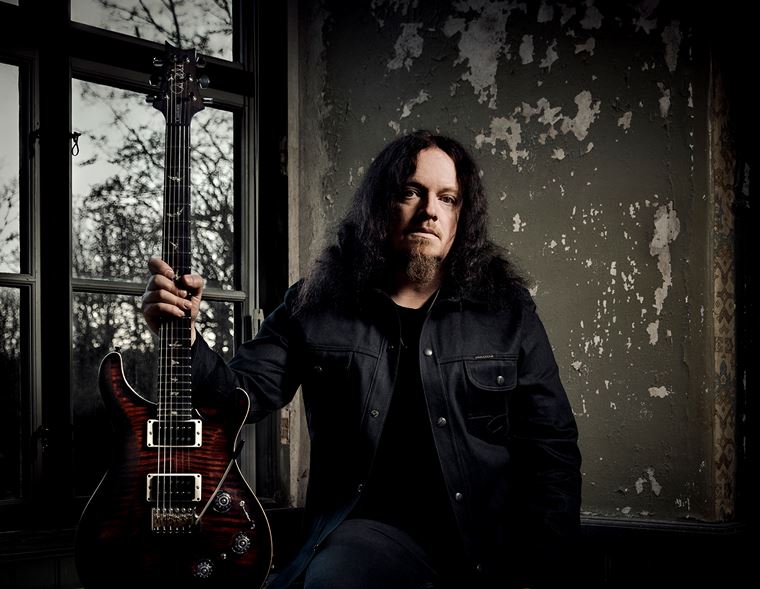Meet Your Maker: John Suhr
Suhr is a byword for great tone and supreme quality. This is how things have been for years, since John Suhr struck out on his own to begin his own company, after time spent with Pensa-Suhr and the Fender Custom Shop, amongst other places. Over the years, John has built guitars for people like Mark Knopfler, Mike Landau and many more. Blending classic shapes with modern thinking and a highly practical mindset, the guitars made by Suhr are highly-performing works of art.
John Suhr, though, is more than just a master guitar builder (as if that wasn’t enough). He certainly is that, but his knowledge and skills encompass more than guitars. His masterful guitars, filled with good taste and subtle innovations, are only one part of the story. His unceasingly enquiring mind has also delved into the world of tube amps, effects pedals and impulse response technology amongst other things.
For years now, guitarists have hailed the praises of John’s American-made tube amps. Models like the PT-15, a versatile tone-monster for Suhr endorsee Pete Thorn, is one of the most sought after ‘boutique’ amps on the planet. Pedals like the Suhr Riot distortion have come along out of the blue and quickly soared to the top in terms of sales and reviews. John Suhr’s work is meticulous, exacting, and, for a great many guitarists, just exactly what they want and need! The company’s continued success comes as no surprise.
At this year’s NAMM trade show, we spotted a very interesting amp sitting at the Suhr stand. It had a distinctly retro look and a super-cool name: the Hombre. Naturally we wanted to know more! We also heard some rumours about a forthcoming ‘John Suhr Signature’ guitar, which instantly got our attention: just what would the man himself choose as the specs for a personal guitar?
Clearly, there was only one man to turn to: John himself! John and I have previous history, having taken part in a three-way chat between himself in California, myself in the UK and Pete Thorn joining us from Japan where he was touring! (Oh, you didn’t see it? Here it is again!) With a successful conversation already behind us, I felt that the opportunity was there to go back to the source and ask about these new developments.
Luckily, John was happy to chat, and so recently, at 5pm in Glasgow and 9am in Lake Elsinore, I phoned John to discuss these exciting new Suhr creations, as well as other subjects such as the secrets of Billy Gibbons’ tone, the truth of Brian May’s and a whole lot more besides!
Guitarguitar: Thanks for agreeing to talk to me first thing in the morning, that’s very good of you!
John Suhr: No problem!
GG: So, I’m just checking in with you today to get the lowdown on what’s new with Suhr in 2020. More specifically, I’d love to hear about the new Hombre amp and the John Suhr Signature model guitar. Are you cool to talk about both of those things?
JS: Oh, sure!
GG: Excellent! Well, why don’t we start with the Hombre? All I have seen is one photo from the NAMM show. Could you tell me a little more about it?
JS: Well, I’m a big Billy Gibbons fan from the early days of ZZ Top, primarily the first three records. It always seemed to be a mystery to me about what he played on those records: we always assume that he’s playing a Les Paul with a Marshall, but in reality, he played more Fender guitars and he also used a lot of small amps. This is an homage to probably...he’s very elusive on what he actually used, but a lot of people assume he used a ‘Brownface’ Deluxe from the same kinda era that I’m talking about, ’63-ish.
GG: Yeah.
JS: So, I happened to come across one for myself. I picked it up and just fell in love with it, especially through a 4x12 cabinet.
GG: Ahhh!
JS: It’s like the dirtiest little amp that ever came from that era (laughs). It’s just a beautiful sound. To me, it’s kind of a hybrid between a Fender and a Marshall but that’s the way they sounded back then too, and that’s the way my amp sounds. So, I noticed that there weren’t really any options in that price range to find these amps: they usually go for over three thousand dollars over here in the States.
GG: Wow.
JS: Probably 35 (hundred dollars), something like that. Then you have to get a lot of work done to then to make them quiet, and they still have some inherent problems in the design that I just feel could do with a little bit of tweaking. But it will capture that era of amp to a T. The goal was to make a very affordable combo that was very light in weight, that was made in our factory, you know? That was not outsourced. We just wanted to offer a quality amp for a cheap price that is really just a very organic, glorious sounding amp for me.
It was kind of a personal thing, I never actually expected anyone to take much of a notice! We all set up the PT 15 Non-IR (as opposed to the fantastic PT15 I.R. amp that combines digital Impulse Responses to the magnificent all-tube Pete Thorn signature amp model - Ray), which I think is very exciting because a lot of people didn’t wanna pay the extra for the reactive load and the I.R.’s (Impulse Responses) when they are buying an amp, so we wanted to have that option, too.
GG: Sure.
JS: But it’s kinda funny how, with all the tech that’s out today, how many people are so excited about this amp and its price point, of course.
GG: Totally! So, um, quite often when people think about vintage combos, it’s all about the pristine, clean bell-like tone. You’re actually talking about the opposite here: getting some real dirt happening.
JS: Oh yeah! Listen to the first three ZZ Top records. I’m pretty well convinced that most of that stuff was an amp exactly like this, if not very similar.
GG: Sweet. And so, am I right in saying that the Hombre has built-in tremolo too?
JS: Um yeah, it’s a ‘bias wiggle’, which is true to that era of amp. It’s not the harmonic trem, so the bias wiggle is truly unique in that it shifts bias point of the amp up and down. It gives a certain flavour that no other...nothing else like that does, really. It’s kind of a special, sought-after thing.
GG: Yeah, totally. Bias tremolo is something you find a lot of modelling devices have tried to emulate over the years. It has that, for want of a better expression, a sort of Tarantino guitar sound, isn’t it?
JS: Yeah! And one unique thing about it too is that, if you play the amp hard, you don’t hear it! In other words, you can control how much of it you hear, just by the dynamics of your playing.
GG: Oh cool!
JS: Because of the bias wiggle, it’s pushing the amp into the hot range and then the cold range as you’re playing, so the louder you play, the more signal’s going through there so it kinda nullifies it a little bit. The louder you crank the amp, the less you’re gonna hear it. But, as you play quieter and softer, it comes out. It’s almost like automatic switching.
GG: Yeah yeah! So, would you suggest guitarists max out the amp and then use their guitar’s volume knob to clean things up?
JS: Well, I don’t think you even need to go there with this amp. You know, unless you’re using single coils, it’s got some natural grit that comes pretty quickly. So if somebody wants a clean sound out of this amp, I recommend they play quietly and they use single coils, which is really what the amp was designed for, initially, I think.
GG: I understand! So, details are still relatively hard to find about the Hombre: is it a 20-watt amp?
JS: Um, yeah, I think it’s supposedly around 20. The actual RMS is about 17 watts on this, clean.
GG: Cool.
JS: And that’s with JJ-6V6’s (valves), which are extremely reliable, but they probably don’t produce the most power, but you know, the addition of 3 or 4 watts really isn’t going to matter.
GG: Yeah.
JS: But if you put NOS (New Old Stock, i.e. vintage, unused) tubes in there, and biased it, I’m sure you could get a good solid 20 watts clean out of it, but I really don’t think that it’s worth the search for the NOS tubes! (laughs) I tell ya, the amp rules with a humbucker. I just wouldn’t expect to get, y’know, sparkly ‘Twin’ clean tones out of it, or anything in the Blackface era, this is not a Blackface amp at all.
GG: Got you.
JS: It’s pretty revered for being the ‘dirty little combo’. Haha!
GG: Yeeeah! Yeah! I can’t wait to hear one of these! So, you mentioned Billy Gibbons earlier. Would you say that PAF humbuckers is the way to go with the Hombre?
JS: Yeah, yeah! I would definitely say that. Something like our Thornbucker (Suhr signature pickup model for Pete Thorn) would work beautifully, and especially with the Aura, haha! (the Aura is Suhr’s fantastic singlecut model)
GG: Exactly!
JS: That’s my goal! But my original thing with the JBL, which is a kind of nasty sounding speaker for that amp, was that we wound up trying a lot of different speakers for it. The Celestion Cream was really nice but it’s just an extremely expensive speaker, and when we got it down to all the testing, the V-type actually was extremely close to the Cream.
GG: Oh!
JS: It really had some great qualities and we didn’t wanna pick a speaker that’s gonna make it sound like a little Marshall because you could easily do that. Like when I plugged it into my 4x12 with Greenbacks, it’s like a cranky little Marshall.
GG: Haha, that’s cool. The Hombre then: is it fair to say that it’s pretty different from the other amps that Suhr make?
JS: Yeah, it’s extremely vintage and it has the heritage that we wanted to show people that, because sometimes people get confused, you know? I mean, let’s face it: everything comes from a GE book or, you know some of the early circuits. You really can’t get more simple than the circuit in this amp. It’s more about the layout and the signal path and the transformers. This is all American iron, and they’re all wound on paper bobbins. We tried to keep everything that mattered tonally, be correct.
GG: Yeah, that’s important. So, could the Hombre be the beginning of a new series of Suhr ‘homage’ amps?
JS: Umm, well uhh...
GG: Hahaha, is it too early to tell?
JS: Haha, it’s...I definitely have other amps I’d love to do! Maybe not in the same flavour, maybe more British, simpler, more straight-forward amps as well.
GG: Cool! Ok, well I won’t push you for too many details there but that’s an exciting prospect. Last time we spoke, I remember you said that one of your favourite gigging guitars was a ‘Junior’ style.
JS: Oh yeah.
GG: I was just wondering about the P90, the Mahogany, the trans Red finish...I’m leading on to the John Suhr Signature guitar but I’m also wondering where that type of P90 sound sits in relation to this sort of amp?
JS: Well, you know, as much as I love a P90, they can get a little bit thick and a little bit overbearing for a lot of modern setups. So, as much as I leaned toward P90s as a kid, I prefer them in a specific guitar, which would be like a double or single cut slab Mahogany body with a shorter scale length.
GG: Got you.
JS: And the P90s with a longer scale length can be nice, but we’ve got that major problem of dealing with noise.
GG: Yes.
JS: So, for convenience sake, I also really like humbuckers, naturally, so I think that, for me, when I was asked ‘what would you do if you were to make something for yourself’, I just figured out that I kinda like...I go back to when I used to play in clubs and you’d have to get so many different sounds in a short amount of time. You need all the help you can get from all your gear.
GG: Yeah.
JS: So, I don’t think a single pickup, or even a couple of P90s is gonna do that. So, for me, I always need that middle pickup to get funky combo tones.
GG: Yeah, the Nile Rodgers sound. Totally.
JS: But, I’m not really a middle pickup person, so I chose the middle (selector) position to be both humbuckers full. And then the two combo positions are the humbuckers with the middle, so you still get the funky stratty-type tones.
GG: Ah, right, okay. So, you’re still getting the double humbucker middle position setting, even though a single coil pickup sits there!
JS: Yeah, so it would be neck full, then neck-split, which would be the neck-coil of the neck pickup with the middle, then both humbuckers full. Then the forward coil of the humbucker with the middle and of course the bridge. I like switching that’s kind of simple, for me.
GG: So, the middle single coil doesn’t get used on its own at all?
JS: Exactly! That’s another thing for me: I hate hum! (laughs) So, that also meant that I didn’t have to put the SSCII (Passive hum cancelling technology used in many Suhr guitars - Ray) in it, which saves some weight. I’m just not a middle pickup guy, but you know, the funny thing is, back in the 80s I made myself a real nice quilt maple Standard, basically, with a Floyd in it, and I put a humbucker and a middle pickup in it.
GG: Mm-hmm.
JS: I didn’t put any neck pickup in it. For me, I wanted those funky coil tones, but I also needed a ripping lead tone! (laughs) I wanted to be able to instantly switch to Nile Rodgers, you know?
GG: Yeah! Of course! Now, one of the things that really intrigued me about your John Suhr Signature guitar is that it has the same locking Wilkinson bridge that you’ve used on the Pete Thorn signature guitar recently, is that correct?
JS: Yeah, I mean that’s something that Trevor and I have been talking about for many years. There was one point where I was talking to Trevor about issues: primarily the low E string and the G string. It’s kinda hard to overcome because it has to do with the saddles and the tension of the strings and the angle of the strings going over the saddles. It’s primarily tension: the string doesn’t track over the saddle, the saddle slips underneath the string.
GG: Okay.
JS: So, Trevor and I, and I’ve done Floyd Roses with no locking nut and, if you do that correctly, it works really well. So, I knew the problem was, you know, primarily in the bridge, so Trevor actually had a nice idea: a way to lock the string down, because I told him I didn’t want a new bridge, I didn’t want a big bulky bridge, I didn’t want anything to get in the way of the player: just try to get rid of this nasty little gremlin that affects certain people, depending on the way ya play!
GG: Haha, yeah!
JS: Y’know, that’s the other thing: some people go ‘I have absolutely no problem with this other bridge’. Well, it really depends so much on what your style is and how you play the guitar. If you’re a guy who dunks the trem to any more than a wiggle, and you also bend a lotta notes, you’re gonna have a problem with the G string, it’s pretty hard to avoid. But if you watch someone like Jeff Beck, he doesn’t do a lot of bending, he uses his bar to do his bends and that’s how he gets away with it! His guitar, when I played it, it won’t stay in tune at all! (laughs) But for him, it’s perfect.
So this idea is something Trevor brought to me many years ago and said, ‘Go ahead: you can have it. Go make it’. Of course, I never got around to it and I don’t exactly have the connections to the suppliers that he does to make bridges like that for a reasonable cost.
GG: Sure.
JS: He eventually decided to do it again and we’ve been working on it for a while. It just works so well! I mean, there’s always gonna be pros and cons about every unit. Of course, one of the cons is that you always have to carry a wrench. But one of the pros is that you can actually swap the saddles out, too. You can get different saddles, put them on...you don’t need to change out the whole bridge just to change what you’re doing. I mean, you could even, if you didn’t mind the look, you could always put a locking saddle on just the G string.
GG: Ah, ok! That’s an interesting idea!
JS: The thing that I really like about it is that I can play, and I don’t have to worry that I’m going out of tune! I can use my bar and it’s gonna stay in tune better than any regular bridge. So, that’s something that I put on my own guitars from the beginning. I was beta testing them along with Pete Thorn and I just had to have that on my guitar! (laughs)
GG: Haha! Nice! So, with this bridge, can you do what I would refer to as ‘full Van Halen’? Like, divebombs and such?
JS: Well yes, but when you don’t have a locking nut, the strings are not gonna drop as fast.
GG: Ahhh.
JS: Without a locking nut the string length is longer and you aren't going to get the immediate divebomb, which is probably an advantage for a lot of people! They don’t wanna hear the slur from a Floyd, and they’re not there to make squeals and noises, they just really want to use the bar and they don’t want it to go out of tune on them.
GG: Absolutely.
JS: If you’re the guy who wants to drop the strings so that they’re falling off the neck, you’re still gonna have to go with the Floyd.
GG: OK, that makes sense. So, is this bridge something that’s exclusive to Suhr at the moment?
JS: No, we had options there, but I don’t mind sharing it with the world so we just told Trevor that he could sell it, y’know.
GG: Ah, right! I couldn’t find much about it online when I was doing my research.
JS: I think he has a Facebook webstore? The guys on the Gear Page are always talking about it. But they do sell saddles, we don’t sell the saddles, but we will sell the bridge on our guitars. You can have it on any custom Suhr. So that’s not a problem. The saddles will work on a Gotoh 510 (Suhr’s preferred brand of non-locking trem) so if somebody has one of our guitars with a recessed bridge, our customers can look them (Wilkinson) up on Facebook. I think the main trouble with them is they’re having trouble keeping stock.
GG: Yeah, I imagine! It’s the answer to so many prayers, isn’t it?
JS: Yeah.
GG: So, going back to your guitar, form what I gather, it’s limited edition. How limited exactly is it going to be?
JS: We’ll take order all of 2020 and then close the books. We’ll then continue building those orders through 2021 to meet those orders.
GG: Okay, cool. Now, it’s a deep, dark Cherry finish and it has a Bakelite pickguard, is that right so far?
JS: Yeah! It’s kind of my homage to Brian May actually!
GG: Oh cool!
JS: You know, there are more ways than one to get a Brian May tone, and when you start playing around with those split tones on a guitar like this, and adding some gain to it, it really does a lot of that thing. But there’s also...when I grew up, it seems like everybody was playing a Les Paul or a Fender and maybe some odd brands out there...most bands sounded very similar to each other, at least in the context of, y’know: Alice Cooper, Kiss, The Who, Hendrix, bands like that.
GG: Sure.
JS: But when Queen came out, they just kinda came outta nowhere, from left-field. The tones that Brian May was getting just absolutely blew me away, you know? I was just so excited about that guitar and the tones he was getting! So, I kind of looked at that Cherry Red...and plus the fact that I’ve played Juniors most of my life, I played Double Cut Juniors and the ones I had were all Cherry Red. So, the kind of Red type of trans finish and... I don’t know if Brian May’s pickguard was Bakelite or gloss or whatever, but that gloss...so, what we do is take that Bakelite and paint it black and gloss it so that it looks like the finish of the guitar. It’s just such a beautiful look, and it’s so classy. Sometimes black plastic starts to make your guitar look cheesy to me, especially when it ages.
GG: Yeah, I know what you mean.
JS: And we do some T-style guitars with the painted Bakelite as well, so. I just thought it was a great look.
GG: It is a great look! I’m really glad I asked that, because I would never have connected Suhr to Brian May in any kind of way, but that makes loads of sense.
JS: Oh yeah, he’s definitely a hero. I also have a T-style guitar that is (made with) White Limba: I absolutely love the tone of that guitar! White Limba with a Pau Ferro fingerboard. Pau Ferro tends to add a lot of the midrange.
GG: Right.
JS: The neck on this one (the John Suhr Signature) is White Limba as well. But also, to try and get a little of that Brian May honk in there, it’s got chambering as well.
GG: Oh cool! Is that under the pickguard, extra routing?
JS: Yeah, I believe Brian May’s guitar has chambers as well, hidden pockets. He probably did it as an attempt to lighten it up.
GG: Haha, yeah because Red Special was made out of a fireplace, right?
JS: Haha, yeah, I think it was Oak or something! But yeah, it definitely gives it a little bit of character, a bit of sweetness to the drive.
GG: Wow, I can’t wait to see and hear it, it sounds like a beautiful guitar. Um, well, I’ve only got a couple of little random questions to finish things off, would that be okay?
JS: Sure!
GG: Cool! One of them is, being that your John Suhr guitar has an H-S-H configuration, as well as lots of other Suhr guitars sharing that and the H-S-S configuration, I was wondering: in your experience, is there a prominent height for the pickups? Are there any special golden rules that you apply then you are determining pickup heights of a guitar that has both humbuckers and single coil pickups? Sometimes it can feel like a battle to not have the humbucker drown out the single coils, you know?
JS: Well, I agree if you play through vintage-style amps. So, if you don’t have any effects and you’re just plugging into an amp, then yeah, definitely! But for me, when I started getting into mixing humbuckers and single coils, I don’t expect the single coils to keep up with the humbucker. I kinda want there to be a difference because generally I’m going to use the humbucker for soloing.
GG: Mmm.
JS: I don’t find it to be that much of an issue, but I tend to like presets and switchability. I mean, one of my major first rigs was a Bradshaw system (Bob Bradshaw, maker of custom pedal switching systems for David Gilmour and others – Ray) which was 22 spaces, full front and back!
GG: Wow.
JS: So, when you go to those clean tones, you automatically kick on your compressor, you could give it a little boost if you want...you know, back in the day, I used to use EMG pickups personally, which had less of the volume difference in between the humbuckers and single coils. But it still had some! With EMGs, when you went to a humbucker and the middle, the humbucker totally drowned out the middle. That’s the reason why on Knopfler’s guitar, I put a little circuit in there that basically killed some of the volume and boosted the high.
GG: Ahhh! That’s interesting!
JS: Yeah, that’s a little thing I did for years. So, Mark could actually use the combo position. With the humbucker, I personally like it hot on a guitar like this, whereas a thick guitar, like a Les Paul, I’m gonna prefer something more PAF. This one has a pretty hot bridge pickup and a pretty clean neck pickup, so when I go to the bridge, typically I’m gonna step on a pedal and I want the output. When I go to the combo position or something that I want clean, I’m going to of course turn off my drive and maybe kick on some compression, or things like that. There’re so many easy ways to do that these days, and of course modelling guys can do that all day long with presets. So, I don’t fight that, I just kind of embrace it.
GG: Cool.
JS: If you do it that way...we all end up doing things that we don’t think we’re gonna have to do! You know, back to my Brian May analogy, when I was a kid, and into my Brian May thing, my father was a businessman who represented a lot of hotels in Europe.
GG: Mm-hmm.
JS: He went to England, and I begged him to bring me back an AC30.
GG: Hahahaha!
JS: It was just so I could get the Brian May tone! So, he brings me back the AC30, and he was probably my age at the time, you know, in his sixties, and I can’t imagine him lugging that amp through the airports! (laughs) Then I pull it out the box, plug it in and turn it on and I’m like...this doesn’t sound anything like Brian May!
GG: Hahahaha! After all that effort, you’re like: wait a minute...what’s missing? Haha!
JS: Haha! So, my point is, is that sometimes you have to do things that you don’t expect you’re gonna have to do. Things don’t work outta the box. In that case, as we’ve learned years later, Brian May was using three pickups wired in series, and that made them pretty dark. On top of that, he primarily used the non-Top Boost channel (on the AC30), he used the normal channel, so all you have is the brilliance and the volume controls, and that’s also pretty dark. What he used, of course, as we all found out, was a treble-booster to take it over the edge and to clean it up.
GG: Yeah, and that’s something you wouldn’t automatically know just form listening to a record. It’s mythological stuff, you just expect it to come straight from the amp, don’t you?
JS: Yeah! So my point there is that even though the pickup combos don’t seem balanced at times, or it can be hard to get the balance, which is another reason why I didn’t choose to put...you can’t go to the middle pickup: all of the positions on this guitar are pretty well balanced, except for the two combos. They’re gonna give you more of that clean, more jangly, single coil kind of vibe. And yeah, without the middle pickup, you can get away with approximating the middle position by using the inside two coils in parallel, things like that, but really, the middle pickup really adds that serious funk, for me. Even when it’s combined with a humbucker split, that middle pickup needs to be there.
GG: I agree.
JS: In fact, I tend to bury that pickup a little bit, because I don’t want it pulling on the strings.
GG: Ah! I was going to ask you about that, since the pickup isn’t being directly heard. One of my main guitars has three humbuckers and I chose that because it looks cool, basically. I don’t really like the functionality of that third pickup, so I sink it pretty low compared to the other two. So, you find that lowering the middle pickup doesn’t affect its performance in terms of what you want it to do?
JS: Well, not when it comes to this guitar: when you split a humbucker, they’re not as powerful as a regular Strat single coil. They’re going to be close, but they’re not going to have the body and the bass and the output unless you’ve got a super-hot humbucker. Plus the fact that the polepieces are not under strings, and the magnets are not the polepieces...there’re so many differences between a humbucker and a traditional single coil.
GG: So.
JS: So, If I lowered the middle pickup a little bit, it’s probably gonna balance better with the split combos. And, like I said, if I just kicked on a little boost if I need it, and compression, I’m ready to go! But yeah, I can’t stand it when it’s in my way!
GG: Haha! Same here! Well John, we started with Billy Gibbons, we added Nile Rodgers and we ended up with Brian May!
JS: Hahaha!
GG: I think we’ve covered it all! Thank you very much for talking to me, I’ll let you get on with your morning, thank you so much!
JS: Thanks Ray!
Well, we covered more than I had anticipated! John shared some really great insights with us, and gave us an amazing impression of his motivations and inspirations. There’s a lot in there, and I hope you give it a nice, slow read to let all of those details sink in! John is one of the most knowledgeable and experienced guitar builders on the planet, so it’s very valuable to us all when he decides to open up and get into specifics! We could have spoken a lot longer, but that’s often the case when two guitar guys get talking! Hopefully there will be further conversations with John to relay in the future, but in the meantime, have a look here at the Suhr Hombre amp and the Suhr John Suhr Signature guitar. The guitar is only available to order this year, so don’t hesitate.
Check out our entire collection of Suhr guitars, amps and effects.
We’d like to thank John for sacrificing his morning and sharing so much cool stuff with us!
Thanks to you for reading, and we’ll see you next time.
Until then,

